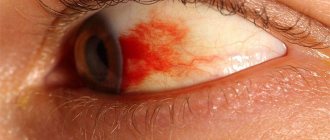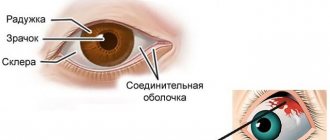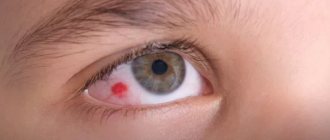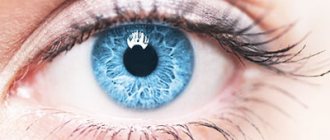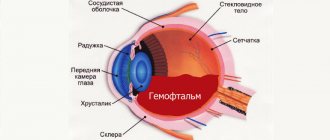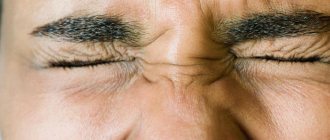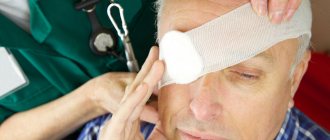Hemorrhage threat
The appearance of bloody spots in the eye is a frightening sight. The person himself does not always notice the changes: the hemorrhage may pass without symptoms or cause mild discomfort, a sensation from the presence of a foreign object in the eye. In most cases, the blood enters the conjunctiva: the multi-layered lining of the eye just below the dense sclera.
There is no danger to vision in this, the stain goes away on its own within 1-3 weeks, and to maintain the health of the organ of vision, you can use disinfecting and vasoconstrictor drops. Effusion of blood into the anterior chamber of the eye, vitreous body or retina is much more dangerous, requires an urgent visit to the doctor and sometimes forces surgery. It does not matter whether the lesion occurs in the right eye or the left.
How to use the products correctly?
The effectiveness of treating a ruptured vessel largely depends on the correct use of ophthalmic drops. So, experts recommend:
- Do not use medications that have expired (indicated on the packaging).
- Before using the drops, wash your hands thoroughly with disinfectant soap.
- Remove lenses before the instillation procedure. You can put on lenses no earlier than 20 minutes after administration of the drug.
- Use the drops exactly in the dosage and exactly the number of times prescribed by your doctor.
The procedure for administering drops is as follows:
- The patient tilts his head back slightly.
- Gently pull back the lower eyelid with the index finger of the right hand (left-handed people can use the opposite hand) and squeeze out the required number of drops (usually no more than 2).
- Keep the eye open for 2-3 seconds, then close it and remove any remaining product from the skin with a dry cloth.
- If necessary, perform the same procedure for the other eye.
Attention! In case of an overdose of the drug or an allergic reaction (itching, lacrimation, etc.), treatment must be suspended and consult a specialist.
Causes of hemorrhages
Like any other organ, the eye is supplied with nutrients through blood vessels. Blood can leave them if the walls cannot withstand the influence of the environment: damage can cause a strong blow, high blood pressure. Thin and fragile capillaries can burst when sneezing, loud screaming, laughing, overexertion - including as a result of constipation. Other events that can cause hemorrhage include:
- reduced blood clotting: hereditary, with vitamin K deficiency, from taking Aspirin, Warfarin and other medications;
- eye surgeries;
- damage to capillaries as a result of infections;
- diabetes;
- retinal atherosclerosis;
- the appearance of blood clots in the vessels of the eyes;
- injuries leading to suffocation;
- diseases that cause severe vomiting;
- smoking, alcohol: bad habits make capillaries even more fragile, they collapse more easily.
In a newborn, red spots on the eyes occur due to errors during childbirth or its severe course: the baby may receive accidental injuries from equipment, suffer from the effects of auxiliary drugs or breathing problems in the woman in labor. It is very easy to damage a child’s fragile blood vessels, but, fortunately, hemorrhages are rarely dangerous. In the first year of life, hemorrhage also occurs due to improper motion sickness, which turns into shaking. To avoid complications, it is better to show your baby to a doctor immediately.
Why does bleeding occur in the eyes?
Bleeding in the eye sometimes does not cause any inconvenience, except for the aesthetic side. But many people do not realize that this can be a sign of illness.
A small spot of blood can gradually cover the entire membrane. The main reason is the fragility of the capillaries that penetrate all tissues. The reason for this condition of the vessels lies in more serious diseases.
- Diabetes. Elevated blood sugar levels contribute to the destruction of blood vessels, which ultimately impairs vision.
- Disease of the eyeball. Conjunctivitis and keratitis are the main causative agents of the problem of hemorrhage.
- Eye injuries lead to rupture of blood vessels.
- Lack of vitamins C and A destroys the walls of blood vessels.
These and many other reasons can lead to hemorrhage. Prolonged work at the computer, physical activity, severe coughing, childbirth, etc. can cause this symptom to occur.
Features of different forms
Only subconjunctival hemorrhage can be treated independently: otherwise it is called hyposphagma. Once between the sclera and the conjunctiva, the blood mixes with the tear secretion, is redistributed and occupies the maximum area, so during the first days the spot may increase. This rarely interferes with vision. It is important to distinguish hypophagma from more dangerous lesions.
- Hyphema
- blood flow into the anterior chamber of the eye, between the convex cornea and the iris. If the chamber is more than half filled with blood, vision loses clarity. This condition requires surgery. Mild forms are treated at home under the supervision of a doctor. - Hemophthalmos
- hemorrhage into the vitreous body. Since blood prevents light from passing through the transparent substance that makes up this part of the eye, vision decreases. - Retinal hemorrhage
is the formation of a blood clot in the retina of the eye. Vision deteriorates, the patient sees spots. This kind of violation is especially dangerous.
When treating serious hemorrhages, you should remain calm, do not leave your bed or engage in physical activity. The affected eye may be covered with a sterile bandage to prevent the introduction of bacteria. The patient is prescribed atropine, drugs to stop bleeding, and glucocorticosteroids. Retinal damage can only be treated in a hospital. For this, a vitrectomy may be prescribed - an operation to remove the clot.
Treatment with folk remedies
If the cause of hemorrhage is fatigue, eyestrain or other external factors (not illness), do the following procedures:
- Tea. Moisten cotton pads with weak tea, squeeze them lightly, apply to the eyelids for 10-15 minutes. Repeat the procedure several times during the day.
- Pharmaceutical chamomile. We do the same as with brewed tea.
- Contrast compresses for the eyes. Pour not too hot water into one container, cold water into the other. Alternately, but for a very short time, apply cotton pads soaked in cold or hot water. We repeat the procedure for 5-10 minutes. After the procedure, lie down for a while with your eyes closed.
Medicinal herbs can help treat hemorrhage:
- Arnica infusion. 10 g of plant flowers or 3 tbsp. pour a glass of boiling water, cover the infusion container, filter and use a tablespoon of infusion inside with milk or water.
- Fresh liquid honey. Place 1 drop in the eyes. Honey not only relieves inflammation, but also promotes the resorption of bruises and nourishes the tissues of the eye.
- Chicory decoction. 3 tbsp. crushed chicory roots, pour 0.5 liters of hot water, bring to a boil and leave to brew for another 15 minutes. Strain. Drink 100 ml 3 times a day; the decoction can also be used as a lotion for the eyes.
- Plant juices. Soak cotton pads in boiled aloe juice and fresh cabbage juice and apply to your eyes for a few minutes. Repeat several times a day.
- Tincture of Sophora. Take equal amounts by weight of the fruits of the Sophora plant and 56% alcohol, leave to infuse for 3 weeks, then filter and store the tincture in the refrigerator. Use as a lotion on the eyes several times a day.
Principles of treatment and types of drops
For therapy to be effective, it is important not only to choose the right eye drops, but also to avoid errors in application. Before instillation, you need to thoroughly wash your hands with soap, and the tip of the dropper should not touch the surface of the eye - these measures will protect against infection. It is more convenient to carry out treatment in a sitting or lying position, with the head tilted back. Typically, drops are placed in the conjunctival sac - the space between the eyelid and the eye. To do this, the lower eyelid is slightly pulled back and the eyes are turned upward. The choice of medicine to quickly resolve a blood stain depends on the condition of the damaged organ and the required measures to protect it.
| A drug | Active substance | Manufacturer | Price |
| Visine classic eye drops 0.05% | Tetrizoline | JOHNSON & JOHNSON LLC (Russia) | 495 rub. |
| Emoxipin eye drops 1% | Methylethylpyridinol | Firm ENZYME LLC (Russia) | 308 rub. |
| Vixipin eye drops 1% | Methylethylpyridinol | GROTEX LLC (Russia) | 275 rub. |
| Taufon eye drops 4% | Taurine | MOSCOW ENDOCRINE PLANT FSUE (Russia) | 156 rub. |
| Defislez eye drops 3 mg/1 ml | Hypromellose | SYNTHEZ JSC (Russia) | 52 rub. |
| Diclofenac eye drops 0.1% | Diclofenac | SC ROMPHARM Company SRL (Romania) | 30 rub. |
| Albucid eye drops 20% | Sulfacetamide | LEKKO CJSC (Russia) | 50 rub. |
| Tobrex eye drops 0.3% | Tobramycin | ALCON-COUVREUR NVSA (Belgium) | 210 rub. |
At the first stage, to prevent the blood stain from increasing, you can use Visine to narrow the blood vessels. To treat the hemorrhage itself, drugs with methylethylpyridinol are recommended: Emoxipin and Vixipin. These products act comprehensively, improve blood circulation and protect tissues, and have few side effects. Also useful during treatment will be reducing inflammation, protecting against dryness, and accelerating the natural processes of tissue healing. To prevent bacteria from taking advantage of the weakness, antibiotics are prescribed.
The patient should give up contact lenses for a while: they may be incompatible with drops and irritate the mucous membrane. There is no need to rub the damaged eye: there is a risk of exacerbating the injury, and dirty hands can introduce germs. During treatment, it is important not to strain your eyesight, rest, and not take blood thinning medications.
Visine is a vasoconstrictor.
Visine for hemorrhage can be used to stop the growth of the blood spot. The drops work due to tetrizoline, a substance that stimulates alpha-adrenergic receptors and constricts blood vessels. The main area of application of Visine is swelling of the eyes due to weather conditions, irritation from chemicals or allergens. The drug is suitable to relieve the effects of prolonged stress.
Visine begins to work a minute after instillation, the effect lasts up to 8 hours.
The drops are suitable for children over 2 years of age, but the period of self-treatment with them is limited for all ages and should not exceed 4 days in a row.
The medicine is applied to the eye 1-2 drops 2-3 times a day. The drug cannot be called completely safe: Visine is not suitable for angle-closure glaucoma, as well as endothelial-epithelial dystrophy of the cornea, in which cells begin to die. If the medicine gets into your eyes, it may cause burning, swelling, or pain.
Drops with emoxipine
Emoxypine is called methylethylpyridinol hydrochloride. The substance belongs to angioprotectors - drugs that improve blood circulation by working with blood vessels and blood properties. Emoxipine makes the vascular wall less permeable and the blood less viscous. The medicine protects cell membranes from free radicals, reduces the need for oxygen and improves microcirculation processes in the eye - the movement of blood through small vessels and fluid between cells. Preparations containing emoxipine protect the retina and accelerate the resorption of blood clots. When using several drugs, drops with emoxipine are instilled last, 15 minutes after the other drugs.
Emoxipin and Vixipin contain the same active ingredient. Medicines help with hyposphagma and hyphema, will be beneficial in case of retinal damage due to diabetes, and are prescribed for corneal burns, cataracts, after operations and for other eye diseases.
For a therapeutic effect, Emoxipin or its analogue should be dripped 2-3 times a day, 1-2 drops at a time. The duration of treatment depends on tolerability and results: usually from 3 to 30 days.
When treating with Emoxipin, a burning sensation is possible. The eyes may become itchy and red. Some people have an allergic reaction. A rare side effect of the drug is thickening of the so-called paraorbital tissues: next to the eye. Drops may be contraindicated for pregnant women.
Taufon - regeneration stimulator
Taurine is an amino acid that stimulates recovery processes and helps the eye return to normal faster. Once at the site of action, the substance improves energy metabolism in cells and helps membranes perform their functions. For glaucoma, the medicine can reduce intraocular pressure. Treatment with taurine is provided by Taufon drops. Taufon will speed up the recovery of the eye from injury and will help with glaucoma, retinal or corneal dystrophy.
There are no contraindications for drops with amino acids; they are suitable for any patients over 18 years of age and without individual intolerance to the drug. To speed up the resorption of a blood clot, Taufon is instilled twice a day. The course lasts from 10 days to 2 weeks.
For injuries, drops should be used for a long time, for a month. Among the side effects, only allergic reactions are known. Even if the active substance is almost not distributed throughout the body after instillation, Taufon is prescribed to pregnant women with caution.
Defislez - moisturizing drops
Hyphenate helps to moisturize and protect the cornea, which is important if the eyes are likely to become dry after a hemorrhage. The drops contain hypromellose. The medicine repeats the natural functions of the tear film and, due to its viscosity, remains on the cornea longer. It is this property that leads to one of the side effects of the solution: a feeling of eyelids sticking together. Another undesirable effect is associated with allergy symptoms due to hypersensitivity to the composition. It is important to know that immediately after the medicine is instilled and for about 15 minutes, vision may be blurred.
The result of treatment with Hyphenosis develops gradually: the eyes become noticeably easier after an average of 4 days, and the course can last 2-3 weeks.
Difislez can be instilled 4-8 times a day, with significant dryness - every hour. The dose of medicine is contained in 1-2 drops. The drug is incompatible with eye drops that contain metal salts.
Defislez helps not only with injuries and hemorrhages: it can be used after operations and procedures on the eyes, burns, hypersensitivity and other conditions when the eye needs additional hydration.
Anti-inflammatory Diclofenac
Diclofenac will come to the rescue if the hemorrhage is caused by injury. The active substance is a non-steroidal anti-inflammatory drug that affects cyclooxygenase enzymes. By blocking their work, diclofenac reduces the production of prostaglandins, and subsequently inflammation and pain in the injured eye decrease. Typically, drops are prescribed after surgery or for conjunctivitis. Before use, shake the bottle with drops, and when used together with other drops, maintain an interval of 5 minutes.
Diclofenac requires careful use. You can treat with drops for no longer than 28 days; they need to be used 4-5 times a day. 2 weeks is usually enough. In addition to burning and temporary vision loss, the drug can cause inflammation of the iris and clouding of the cornea. When absorbed, the medicine can cause nausea and vomiting.
The well-being of children, pregnant women and the elderly should be monitored especially carefully. If you have bleeding disorders, which sometimes lead to hemorrhages, drops may not be suitable. You should also be afraid of allergies: especially when bronchial asthma is combined with chronic sinusitis or rhinitis.
Antibacterial drugs
To cope with possible infection in the eye, you can use antibacterial drops. They will prevent bacteria from multiplying in damaged tissues and causing complications. These medications include Tobrex and Albucid.
- Tobrex
contains tobramycin, an antibiotic that prevents bacteria from properly synthesizing protein and changes the permeability of their cytoplasmic membranes. The dose is selected individually. - Albucid
- drops with sodium sulfacetamide. Bacteria absorb the substance instead of para-aminobenzoic acid, which prevents them from synthesizing compounds necessary for development and leads to growth arrest. Albucid should be instilled 5-6 times a day, 2-3 drops until recovery.
Sulfacyl sodium may cause redness in the eye, swelling, itching, but is generally well tolerated and can be used in children. Tobrex can lead to similar reactions. Also, the remedy sometimes leads to dry eyes, pain, lacrimation, and blurred vision. Entering the blood, Tobrex can also affect the nervous system, causing headaches.
Potassium Iodide is also useful for eye damage. Drops with a 3% solution will help quickly remove hemorrhage and protect the eye from bacteria. You need to instill the product 2 drops up to 4 times a day, treatment takes 2 weeks. Before use, it is important to pay attention to the condition of the thyroid gland and kidneys: disruption of their function may become a contraindication.
Which drops are best for eye hemorrhage?
The problem of damage to small blood vessels is very common among different age groups. Before buying a product, you need to consult a doctor so that he can determine the cause of the symptom and prescribe the appropriate solution.
Which drops are best for bleeding from the eyes? Those that have an antibacterial and soothing effect. Many modern drugs can strengthen the walls of blood vessels to avoid repeated ruptures without medical intervention.
Today, there are many manufacturers that produce medications for this disease. The ranking of the best is occupied by both domestic and foreign representatives. All products are selected according to the following parameters:
- Date of manufacture and duration of storage. It is necessary to carefully study the instructions before using the product so that it is not expired.
- Compound. It will indicate the ingredients that were used to prepare the solution and what functions they perform.
- Duration of treatment. It all depends on the degree of damage and the cause. This is determined by the attending physician.
- Equipment. A big plus will be the additional pipette, which is not always included in the package.
- Efficiency. Depends on numerous factors and is often determined experimentally.
A review of medications for hemorrhage in the eye will help the user decide on the highest quality and most effective remedy. Which drops are best to use is up to the consumer to decide, and he can learn about the characteristics and properties of each type from the introductory article.

